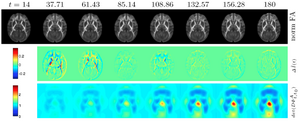Projects:LongitudinalAtlasBuilding
Back to UNC Algorithms
Longitudinal atlas building
As part of the longitudinal intra- and interpatient analysis theme within NA-MIC, we are working on a deformable, longitudinal DTI atlas method. Our initial approach is based on intensity calibrated images assuming homogenous intensity across the time scale. This longitudinal framework explicitly accounts for temporal dependencies via iterative subject-specific statistical growth modeling, and cross-sectional atlas-building. To effectively account for measurements sparse in time, a continuous-discrete statistical growth model is proposed incorporating also patient co-variates
Description

The initial longitudinal framework explicitly accounts for temporal dependencies via iterative subject-specific statistical growth modeling , and cross-sectional atlas-building using a deformable LDDMM based registration approach. To effectively account for measurements sparse in time, a continuous-discrete statistical growth model is proposed incorporating also patient co-variates. This initial approach is based on intensity calibrated images assuming homogenous intensity across the time scale.
Currently we are working on incorporating the intra and inter-subject registration jointly, as well as modeling longitudinal changes both in shape as well as intensity.
Publications
Key Investigators
- UNC Algorithms: Marc Niethammer, Istvan Csapo, Yundi Shi, Martin Styner